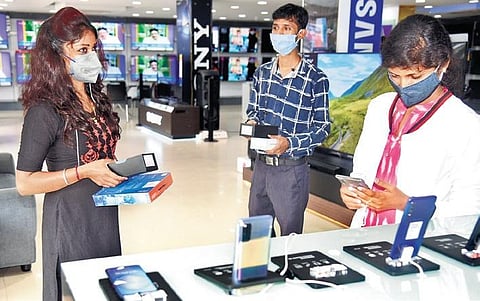

NEW DELHI: Voices averse to trade ties with China have been growing louder amidst the ongoing border stand-off.
This week's clash has only led to a vociferous call for a boycott of Chinese goods from the Indian market even though the Centre had said earlier that building a Atmanirbhar Bharat (self-reliant India) should not be misconstrued as "protectionism".
On Thursday, traders' body CAIT has released a list of more than 500 Chinese products to be boycotted which include FMCG products, consumer durables, toys, cosmetics, bags, textiles, builder hardware, footwear, apparel, kitchen accessories, among others.
That apart, RSS affiliate Swadeshi Jagran Manch has also been stressing on boycotting Chinese products.
"Despite loss of business, we urge the government to take immediate steps to curb Chinese dominance. We have stepped up our nationwide movement against the boycott of Chinese goods, which started on June 10, with an objective to reduce imports by $13 billion or about Rs 1 lakh crore by December 2021," said CAIT Secretary General Praveen Khandelwal, adding the matter will be soon taken up with Union Commerce Minister Piyush Goyal.
Broadly, the Confederation of All India traders (CAIT) has lined up more than 3,000 items that it says “are made indigenously in India also, but succumbing to the temptation of cheap items.”
While the association argues that manufacturing of these items “does not require any sophisticated technology" and even if they do, India is well equipped, economists beg to differ.
“We are dependent on China in certain industries where there are no alternative sources available," says Prof Biswajit Dhar of JNU’s Centre for Economic Studies and Planning.
Take the case of toys --- how many companies actually make it in India? There is a high demand for toys, but most of it is met through imports.
In February 2020, the Centre had proposed raising import duty on toys to 60 per cent from the existing 20 per cent. For India, which imports toys worth around ₹2,500 crore annually and of which 75 per cent are from China, the move was seen as a rude shock with importers protesting against the move.
The hike, they said, cannot be absorbed by the market as it will make the goods unaffordable for the masses, eventually resulting in closure of businesses.
Similarly, mass products such as needles are imported in bulks not because of manufacturing constraints but because India doesn't have the capability to match Chinese price.
According to data from the Export & Import Data Bank under the Ministry of Commerce and Industry, the principal imports from China are electrical equipment, nuclear reactors, organic chemicals, fertilisers, articles of iron and steel, medical or surgical equipment and auto components.
IMF figures reveal that India has a trade deficit of $60 billion, a whopping jump from a meagre trade surplus in the early 2000s, in 2019-20.
While imports soared, India’s low volume of exports to China remained limited to raw materials, such as low-grade ores, cotton, and chemicals.
A reversal in this trend seems to be a tall order in the short term considering the penetration of Chinese products in India unless the country reduces its import dependence and strengthens its export capabilities.
While the country is pushing for local manufacturing for many products, factories and production will take time to materialise. Besides, a blanket ban on imports is unlikely as it may prove counterproductive as India is also highly dependent on China for raw materials and semi-finished products.
Interestingly, the Indo-China camaraderie is much deeper than what it appears.
China, for instance, has marketed its consumer goods brands such as Xiaomi or Haier separately in India, indeed as competitors, in an aggressive strategy to capture market share, points out Ananth Krishan, visiting fellow, Brookings India.
The investments have largely been driven by market compulsions.
Post 2014, the massive inflow of Chinese capital through the private sector in India has changed the nature of China Inc engagement with India.
What is striking about this change— which raised the stakes of Chinese companies in the Indian market—is that it largely happened without the involvement of both the governments, and was led by the private sector in both countries.
This has been especially evident in the spate of acquisitions in the Indian tech companies that gives them an enduring stake in the Indian market, he adds.
From payments apps that record every user's private transaction to entertainment apps such as Tiktok, the footprint of Chinese stakes in new areas has been steadily increasing.
Real estate is the newest emerging interest which coincides with the slowdown in China’s domestic real estate market.
Players such as China Construction Third Engineering Bureau have invested in India while several others are trying to make inroads.
Meanwhile, direct takeovers of vulnerable, pandemic-hit Indian companies, however, now requires mandatory approval from the Centre.
The move comes against the backdrop of March shareholding disclosures that had revealed that the Chinese central bank now held a 1.01 per cent stake in one of India's biggest blue-chip financial firms: HDFC.
"India’s market is seen as similar to China’s in terms of size, viewed by many Chinese tech firms as the next big thing.
"The changing nature of India’s trade and investment relations with China presents both opportunities and challenges for India in pursuing its strategic and commercial goals. There's an underlining the need for a transparent and effective regulatory framework, rethinking trade strategies that strikes a better balance between creating a friendly, open and predictable investment environment on the one hand, and safeguarding longer-term considerations of security and privacy on the other," Krishan wrote in his impact series “Following the money: China Inc’s growing stake in India-China Relations."